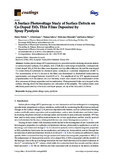| dc.contributor.author | Wafula, Henry | |
| dc.contributor.author | Juma, Albert | |
| dc.contributor.author | Sakwa, Thomas | |
| dc.contributor.author | Musembi, Robinson | |
| dc.contributor.author | Simiyu, Justus | |
| dc.date.accessioned | 2023-07-06T11:22:21Z | |
| dc.date.available | 2023-07-06T11:22:21Z | |
| dc.date.issued | 2016-07-22 | |
| dc.identifier.uri | https://doi.org/10.3390/coatings6030030 | |
| dc.identifier.uri | https://www.mdpi.com/2079-6412/6/3/30 | |
| dc.identifier.uri | http://ir-library.mmust.ac.ke:8080/xmlui/handle/123456789/2255 | |
| dc.description.abstract | Surface photovoltage (SPV) spectroscopy is a powerful tool for studying electronic defects on semiconductor surfaces, at interfaces, and in bulk for a wide range of materials. Undoped and Cobalt-doped TiO2 (CTO) thin films were deposited on Crystalline Silicon (c-Si) and Flourine doped Tin oxide (SnO2:F) substrates by chemical spray pyrolysis at a substrate temperature of 400 °C. The concentration of the Co dopant in the films was determined by Rutherford backscattering spectrometry and ranged between 0 and 4.51 at %. The amplitude of the SPV signals increased proportionately with the amount of Co in the films, which was a result of the enhancement of the slow processes of charge separation and recombination. Photogenerated holes were trapped at the surface, slowing down the time response and relaxation of the samples. The surface states were effectively passivated by a thin In2S3 over-layer sprayed on top of the TiO2 and CTO films. | en_US |
| dc.language.iso | en | en_US |
| dc.publisher | MDPI | en_US |
| dc.subject | Surface, Photovoltage, Study, Surface, Defects, Co-Doped, TiO2, Thin, Films, Deposited, Spray, Pyrolysis | en_US |
| dc.title | A Surface Photovoltage Study of Surface Defects on Co-Doped TiO2 Thin Films Deposited by Spray Pyrolysis | en_US |
| dc.type | Article | en_US |

